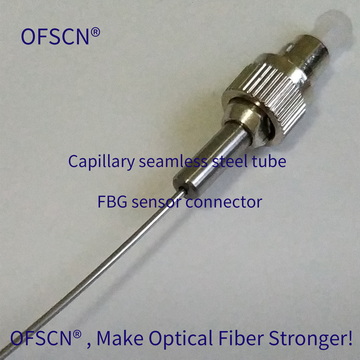Nuclear power is one of the most efficient and clean sources of energy in the world. However, ensuring the safety and reliability of nuclear power plants is of utmost importance. One critical aspect of nuclear power plant safety is monitoring the temperature of nuclear fuel rods. This task is challenging and requires advanced sensing technologies to ensure accurate measurements. Fiber grating sensing technology offers a potential solution to this challenge and is gaining attention in the nuclear power industry. In this article, we will discuss the problems that fiber grating sensing technology can solve, and how Beijing Dacheng Yongsheng Technology Co., Ltd.(short for DCYS ) can support the temperature monitoring of nuclear fuel rod in the field of nuclear power.
Fiber Bragg Grating Sensing Principle:
Fiber Bragg gratings (FBGs) are periodic structures that are inscribed in the core of an optical fiber. These structures reflect a specific wavelength of light that is determined by the periodicity of the grating. When the grating is subjected to mechanical or thermal strain, the reflected wavelength changes in a predictable manner. By monitoring the reflected wavelength, changes in strain, temperature, and other parameters can be detected. FBG sensors can be used to monitor a wide range of parameters, including strain, stress, temperature, and vibration.
Click the link below for more details:
Demand Analysis for Temperature Monitoring of Nuclear Fuel Rods:
Nuclear fuel rods are a critical component of a nuclear reactor, and their temperature must be closely monitored to ensure safe and efficient operation. Accurate temperature measurements are essential to prevent fuel failure, which can lead to radiation leaks and other hazardous situations. Therefore, temperature monitoring of nuclear fuel rods is a crucial aspect of nuclear power plant safety.

Why Temperature Monitoring of Nuclear Fuel Rods is Required :
Nuclear fuel rods contain nuclear fuel, which generates heat through nuclear reactions. The heat produced must be controlled to prevent the fuel from overheating and melting, which can cause a nuclear meltdown. Therefore, it is essential to monitor the temperature of nuclear fuel rods to ensure that they remain within a safe operating range.

Difficulties in Temperature Monitoring of Nuclear Fuel Rods:
Temperature monitoring of nuclear fuel rods is challenging due to the extreme conditions within a nuclear reactor. The high levels of radiation, high temperatures, and corrosive environment can degrade conventional temperature sensors, leading to inaccurate measurements. Furthermore, access to the fuel rods is limited, making it challenging to install and maintain sensors. Therefore, advanced sensing technologies are required to overcome these challenges and ensure accurate temperature measurements.
Recommended fiber grating temperature sensors:
What Problems can be Solved by FBG Sensing Technology:
与用于核燃料棒温度监测的传统温度传感器相比,光纤光栅传感技术具有多项优势,FBG传感器不受电磁干扰,使其适合在核反应堆的恶劣条件下使用,它们也很小,可以很容易地安装在或嵌入燃料棒上,从而实现精确的温度测量。此外,FBG 传感器可以实时测量温度变化,从而能够对任何温度偏差做出快速响应。北京大成永盛科技有限公司是光纤光栅传感器的专业制造商,能为客户提供最适合的产品及解决方案。

Beijing Dacheng Yongsheng Technology Co., Ltd.:
Beijing Dacheng Yongsheng Technology Co., Ltd.(short for DCYS) is a professional manufacturer of fiber grating sensors, fiber grating demodulators and system software. Specializing in the production of various fiber grating sensors, including temperature, strain, stress, displacement, vibration, shape sensors, etc. DCYS also produces fiber grating demodulators, and can customize and develop related application software.
Recommended fiber grating demodulator:
Product Alias: Fiber Bragg Grating Interrogator, FBG Interrogator, FBG Sensor Interrogator, Fiber Optic Grating Interrogator, Fiber Bragg Grating Demodulator, FBG Demodulator, Fiber Optic Grating Demodulator
This product is produced by DCYS, and it is a high-speed high-frequency fiber Bragg grating demodulator(Interrogator). The fiber grating demodulator is compatible with various specifications and models of OFSCN® fiber bragg grating sensors (temperature, strain, stress FBG sensors, etc.). It features adjustable port density (4, 8, 16 channels) and high-speed high-refresh rate capabilities.
DCYS Helps to Monitor the Temperature of Nuclear Fuel Rod:
DCYS can provide customized solutions for temperature monitoring in nuclear fuel rods. DCYS's FBG sensors are small and can be easily embedded in fuel rods , allowing for accurate and continuous temperature monitoring in real-time. This can help detect any anomalies or overheating in the fuel rods, which is crucial for ensuring the safety and efficiency of nuclear reactors.
In addition, DCYS's sensors are highly reliable and resistant to harsh environments, making them ideal for use in the extreme conditions of a nuclear reactor. DCYS can also develop customized software to analyze the data collected by the sensors, allowing for better understanding and control of the temperature of the fuel rods.

Other Points Need to Be Clarified:
By using fiber grating sensing technology for temperature monitoring of nuclear fuel rods, many of the difficulties associated with traditional temperature monitoring methods can be overcome. For example, the use of thermocouples can lead to inaccurate temperature readings and can be difficult to maintain and replace in a nuclear reactor environment. In contrast, FBG sensors are more accurate, reliable, and require less maintenance.
Overall, the use of fiber grating sensing technology for temperature monitoring of nuclear fuel rods is a promising solution that can improve the safety and efficiency of nuclear power plants. Beijing Dacheng Yongsheng Technology Co., Ltd. is a professional manufacturer of fiber grating temperature sensors and can provide customized solutions to meet the specific needs of nuclear power facilities.
